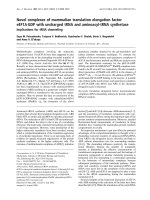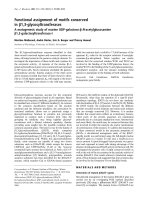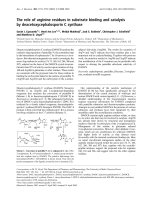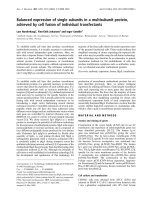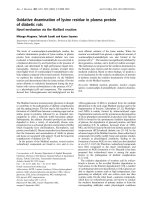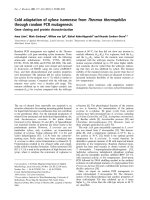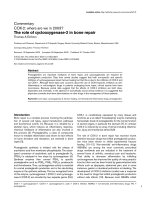Báo cáo y học: "Four-year follow-up of infliximab therapy in rheumatoid arthritis patients with long-standing refractory disease: attrition and long-term evolution of disease activity" pot
Bạn đang xem bản rút gọn của tài liệu. Xem và tải ngay bản đầy đủ của tài liệu tại đây (446.14 KB, 7 trang )
Open Access
Available online />Page 1 of 7
(page number not for citation purposes)
Vol 8 No 4
Research article
Four-year follow-up of infliximab therapy in rheumatoid arthritis
patients with long-standing refractory disease: attrition and
long-term evolution of disease activity
Bert Vander Cruyssen
1
, Stijn Van Looy
2
, Bart Wyns
2
, Rene Westhovens
3
, Patrick Durez
4
, Filip Van
den Bosch
1
, Herman Mielants
1
, Luc De Clerck
5
, Ann Peretz
6
, Michel Malaise
7
, Leon Verbruggen
8
,
Nathan Vastesaeger
9
, Anja Geldhof
10
, Luc Boullart
2
and Filip De Keyser
1
1
Department of Rheumatology, Ghent University Hospital, B-9000 Gent, Belgium
2
Department of Electrical Energy, Systems and Automation, Ghent University, Gent, Belgium
3
Department of Rheumatology, University Hospitals K.U. Leuven, Leuven, Belgium
4
Department of Rheumatology, Cliniques Universitaires Saint-Luc, Brussels, Belgium
5
Department of Rheumatology, University Hospital Antwerp, Antwerp, Belgium
6
Department of Rheumatology, University Hospital Brugmann, Brussels, Belgium
7
Department of Rheumatology, University Hospital Liège, Liège, Belgium
8
Department of Rheumatology, AZ Vrije Universiteit Brussel, Brussels, Belgium
9
Department of Medical Affairs, Schering-Plough, Brussels, Belgium
10
Department of Medical Affairs, Centocor BV, Leiden, the Netherlands
Corresponding author: Bert Vander Cruyssen,
Received: 27 Mar 2006 Revisions requested: 11 May 2006 Revisions received: 12 Jun 2006 Accepted: 29 Jun 2006 Published: 17 Jul 2006
Arthritis Research & Therapy 2006, 8:R112 (doi:10.1186/ar2001)
This article is online at: />© 2006 Vander Cruyssen et al.; licensee BioMed Central Ltd.
This is an open access article distributed under the terms of the Creative Commons Attribution License ( />),
which permits unrestricted use, distribution, and reproduction in any medium, provided the original work is properly cited.
Abstract
Although there is strong evidence supporting the short-term
efficacy and safety of anti-tumour necrosis factor-α agents, few
studies have examined the long-term effects. We evaluated 511
patients with long-standing refractory rheumatoid arthritis
treated with intravenous infusions of infliximab 3 mg/kg at weeks
0, 2, 6, and 14 and every 8 weeks thereafter for 4 years. Among
the initial 511 patients included in the study, 479 could be
evaluated; of these, 295 (61.6%) were still receiving infliximab
treatment at year 4 of follow-up. The most common reasons for
treatment discontinuation were lack of efficacy (65 patients,
13.6%), safety (81 patients, 16.9%), and elective change (38
patients, 7.9%). Analysis of disease activity scores (DAS28
[disease activity score based on the 28-joint count]) over time
showed that, after the initial rapid improvement during the first 6
to 22 weeks of therapy, a further decrease in disease activity of
0.2 units in the DAS28 score per year was observed. DAS28
scores, measured at week 14 or 22, were found to predict
subsequent discontinuation due to lack of efficacy. In
conclusion, long-term maintenance therapy with infliximab 3 mg/
kg is effective in producing further reductions in disease activity.
Disease activity measured by the DAS28 at week 14 or 22 of
infliximab therapy was the best predictor of long-term attrition.
Introduction
After demonstration of effectiveness of anti-tumour necrosis
factor (TNF)-α agents in patients with rheumatoid arthritis (RA)
[1-3], their use has become common practice in treating
patients with RA not responding to classical disease modify-
ing anti-rheumatic drugs (DMARDs). Although there is strong
evidence in support of the short-term efficacy and safety of
these agents, data are still insufficient with regard to the long-
term effects.
Long-term treatment continuation rates reflect safety, efficacy,
and compliance to therapy and may vary between data from
clinical trial extensions and treatment registries. Infliximab, pri-
marily used in combination with methotrexate (MTX), is a highly
ACR = American College of Rheumatology; AUC = area under the curve; CI = confidence interval; CRP = C-reactive protein; DAS28 = disease
activity score based on the 28-joint count; DMARD = disease-modifying anti-rheumatic drug; ESR = erythrocyte sedimentation rate; HAQ = health
assessment questionnaire; MTX = methotrexate; RA = rheumatoid arthritis; ROC = receiver operating characteristic; SD = standard deviation; SE =
standard error; SF = short form; TNF = anti-tumour necrosis factor; VAS = visual analogue scale.
Arthritis Research & Therapy Vol 8 No 4 Cruyssen et al.
Page 2 of 7
(page number not for citation purposes)
effective therapy for the majority of patients with RA [4]. After
an induction scheme with intravenous infliximab infusions
given at weeks 0, 2, and 6, infliximab is typically administered
at a dosage of 3 mg/kg every 8 weeks in combination with
MTX. However, results of the ATTRACT (Anti-TNF Trial in
Rheumatoid Arthritis with Concomitant Therapy) trial sug-
gested that a higher dosage (10 mg/kg every 8 weeks) or a
shorter perfusion interval may add benefit, which is reflected
by the use of dosage increases in some studies [5,6].
In most countries, anti-TNF-α therapy is reserved for patients
who are refractory to classical DMARD therapy. These
patients may require TNF-α blockade for an extended time.
We analysed data from patients who entered the Belgium
expanded access program and received infliximab 3 mg/kg in
combination with MTX. Patients in this program could receive
infliximab therapy (provided by Schering-Plough, Brussels,
Belgium) until the product became reimbursed. We aimed to
(a) evaluate attrition of infliximab therapy in patients with long-
standing refractory RA over a 4-year period, (b) document the
reasons for discontinuation, (c) describe the long-term course
of disease activity, and (d)evaluate early predictors of long-
term continuation of the therapy.
Materials and methods
Study population
Five hundred eleven patients with RA entered the Belgium
expanded access program between February 2000 and Sep-
tember 2001. These were the first Belgian patients to be
treated with TNF blockade outside of the clinical trial setting
after EMEA (European Medicines Evaluation Agency)
approval of infliximab for the treatment of patients with RA and
to receive infliximab from Schering-Plough for free as part of a
Medical Need Program (the Belgian expanded access pro-
gram) until the product became reimbursable.
Patients were observed at seven Belgian university centres.
Clinical evaluations performed with each infliximab infusion
included the 28 and 66/68 swollen and tender joint counts,
erythrocyte sedimentation rate (ESR) (mm/hour), C-reactive
protein (CRP) (mg/l), health assessment questionnaire
([HAQ] on a scale of 0–3) [7], physician's global assessment
of disease activity using a visual analogue scale ([VAS] 0–100
mm), patient's global assessment of disease activity (VAS 0–
100 mm), patient's assessment of pain (VAS 0–100 mm),
patient's assessment of fatigue (VAS 0–100 mm), and all sub-
scales of the short form (SF)-36 questionnaire (0–100 points)
[8].
Along with the clinical evaluations performed on the day of
each infusion, all physicians completed an evaluation of the 4-
year experience. The evaluation provided an assessment of the
actual therapy patients were receiving by year 4. If patients
were withdrawn from infliximab therapy, the following informa-
tion was collected: reasons for withdrawal (inefficacy, safety,
death, or lost to follow-up); DAS28 [9,10]; physician's global
VAS, CRP, and HAQ scores prior to infliximab withdrawal; and
actual therapy at year 4.
All patients had long-standing, active, refractory RA. After an
induction regimen of 3 mg/kg at weeks 0, 2, and 6, all patients
received maintenance therapy every 8 weeks. At week 22, the
treating rheumatologist had the option of increasing the dos-
age by 100 mg [11,12]. The standard infliximab dosage of 3
mg/kg every 8 weeks was reinstituted in a majority of patients
beginning in June 2002, the time at which infliximab became a
reimbursable medicine in Belgium. During the first 6 months,
steroid and MTX dosages were kept stable; dosages could be
adjusted from month 6 onward.
All patients gave written informed consent.
Variables evaluated in the prediction of infliximab
continuation
To predict long-term continuation of infliximab therapy early in
the treatment course, we assessed the relationship between
infliximab discontinuation and the following single variables at
each of weeks 0, 6, 14, and 22: 28 and 66/68 swollen/tender
joint counts, ESR, CRP, HAQ, physician's global assessment
of disease activity, patient's global assessment of disease
activity, patient's assessment of pain (VAS 0–100 mm),
patient's assessment of fatigue, and all subscales of the SF-36
questionnaire. The patients' DAS28 scores and response (no,
moderate, or good) and the American College of Rheumatol-
ogy (ACR) response (no, 20, 50, or 70) were calculated after
data collection so that the treating rheumatologist was una-
ware of the exact values of those composite scores [9,10,13].
Statistical analysis
Statistical methods available in a classical statistical package
(SPSS 12.0; SPSS Inc., Chicago, IL, USA) were employed in
all analyses. The estimation of the slope of the course of dis-
ease activity from week 22 forward was estimated by means
of linear mixed model analysis with an unstructured covariance
matrix with random intercept and random slope [14]. Measure-
ments from weeks 0, 6, 14, and 22 and the last clinical evalu-
ation were included, as were available measures from other
time points. When necessary, the continuous variables were
normalised by taking the square root of the joint counts and
the natural logarithm of CRP and ESR. Areas under the curve
(AUCs) of receiver operating characteristic (ROC) curves
were calculated. A higher AUC indicates that a single variable
has better discriminative characteristics. The cutoff of the con-
tinuous variables was adapted to the same specificity level as
the categorical variable so that sensitivities could be evaluated
and compared between continuous and categorical variables
[15]. The selection and comparison of variables by ROC-curve
analysis was performed because this method gives a valid
ranking of variables and does not depend on the number of
Available online />Page 3 of 7
(page number not for citation purposes)
patients available for that specific variable (in contrast to rank-
ing methods based on p values) [16].
Survival analysis and predictors of continuation of infliximab
therapy were analysed by means of Kaplan-Meier analysis and
Cox regression. Cox regression analysis was performed with
the default options of SPSS 12.0, and stepwise construction
of models was performed by conditional forward and back-
ward elimination using the strategy described by Hosmer and
Lemeshow [17]. Survival data were calculated after censoring
at 4 years.
Results
Continuation rates of infliximab therapy
Of the initial 511 patients enrolled in the study, 507 effectively
started infliximab therapy. All patients had long-standing,
active, refractory RA, which is reflected by a mean baseline
failure of 3.9 DMARDs and a mean disease duration of 10
years at baseline. After 4 years, 12 (2%) patients treated with
infliximab had died (3 patients due to infections, 5 due to car-
diovascular disease or lung embolism, and 4 due to other rea-
sons; no patients died due to tuberculosis or anaphylactic
reactions), and 16 (3%) patients were lost to follow-up. Of the
479 remaining patients, 295 (61.6%) patients were still
receiving infliximab treatment after 4 years of therapy. One
Figure 1
Flow chart of the patient populationFlow chart of the patient population. ITT= intention to treat.
Figure 2
Kaplan-Meier plot and cumulative discontinuation due to the different stop reasonsKaplan-Meier plot and cumulative discontinuation due to the different
stop reasons.
Arthritis Research & Therapy Vol 8 No 4 Cruyssen et al.
Page 4 of 7
(page number not for citation purposes)
hundred eighty-four (38.4%) patients were withdrawn from
treatment for the following reasons: 81 (16.9%) due to safety
issues (including 28 infections, 18 immune-allergic reactions,
and 9 malignancies), 65 (13.6%) due to inefficacy, and 38
(7.9%) for elective reasons (Figure 1). The main elective rea-
son to stop infliximab treatment was the decision by the physi-
cian or the patient to switch to a subcutaneous TNF-α blocker.
Those subcutaneous TNF-α blockers became available in
February 2003 for etanercept and in May 2004 for adalimu-
mab. Figure 2 provides the Kaplan-Meier plot of the attrition on
infliximab therapy, illustrating the continuation rates after 1, 2,
and 3 years; these data are also displayed in Table 1.
Evaluation of the actual therapy at year 4 in the patients
withdrawn from infliximab therapy
Data on the current DMARD or newly started biological ther-
apy could be obtained in 142 of the 184 patients who discon-
tinued infliximab therapy. Fifty percent of patients were
switched to another biological therapy (Table 2).
Evolution of the DAS28 score over time
Patients continuing with infliximab therapy had a mean (stand-
ard deviation [SD]) DAS28 score of 3.0 (SD 1.3) at the year 4
clinical evaluation. In comparison, the mean DAS scores
before the stop of therapy were 5.4 (SD 1.5) among patients
who stopped due to inefficacy, 3.5 (SD 1.3) in patients who
stopped due to safety reasons, and 3.0 (SD 1.0) in the
patients withdrawn from infliximab for elective reasons.
DAS28 scores at the relevant time points are depicted in Fig-
ure 3. This figure also suggests that, after an initial rapid
decrease in disease activity between weeks 0 and 6, there
appears to be a further decrease in disease activity through
year 4. This decrease, calculated in the total population (all
patients, including those who withdrew from therapy due to
inefficacy), was estimated as a mean of 0.2 (standard error of
the mean 0.03, p < 0.0001) DAS units per year. The same
results were obtained in models that corrected for infliximab
dosage and/or concomitant corticosteroid, MTX, or lefluno-
mide use by adding them as (non-significant) covariates to the
mixed models analysis.
Among the patients still receiving infliximab at year 4, 62% had
a low level of disease activity, as defined by a DAS28 score of
less than 3.2. Nearly half (49.5%) of these patients had mini-
mal disease activity (DAS28 less than 2.85 or no swollen
joints, no tender joints, and ESR less than 10 [18]). Of note,
17.4% of the patients had no swollen joints, no tender joints,
and an ESR less than 10.
Prediction of attrition of infliximab therapy
Ranking of all clinical evaluations conducted at weeks 0, 6, 14,
and 22 showed that the DAS28 scores at weeks 14 and 22
are the most important measurements in predicting later with-
drawal from infliximab therapy due to inefficacy, with ROC
AUCs of 0.731 (standard error [SE] 0.06) and 0.706 (SE
0.06), respectively. None of the other parameters evaluated for
prediction of treatment withdrawal had an AUC higher than
0.65, and they were therefore omitted from further evaluation.
We combined in one Cox regression model the continuous
DAS28 scores (at week 14 or week 22) with the response
scores (ACR 20–50–70 response and no-moderate-good
DAS response score). None of the models showed a signifi-
cant additional value of those response scores to the continu-
ous DAS28 alone. This indicates that the DAS28 at week 14
Table 1
Infliximab attrition rates at different time points
Global continuation rates Discontinuation rates
Inefficacy Elective Safety
Year Percentage 95% CI Percentage 95% CI Percentage 95% CI Percentage 95% CI
1 90.9 88.3 93.5 1.8 0.6 3.0 0.9 0.1 1.7 6.4 4.2 8.6
2 80.7 77.2 84.2 6.4 4.2 8.6 1.4 0.3 2.5 11.5 8.6 14.4
3 69.6 65.5 73.7 11.2 8.4 14.0 3.4 1.8 5.0 15.8 12.5 19.1
4 61.6 57.2 66.0 13.6 10.5 16.7 7.9 5.5 10.3 16.9 13.5 20.3
CI, confidence interval.
Table 2
Use of biologic agents after withdrawal of infliximab therapy
New
biologic
therapy
Reason for withdrawal Total
Lack of
efficacy
Patient
request
Safety
issues
None 24 3 44 71
Adalinumab 10 23 3 36
Etanercept 6 4 8 18
Rituximab8019
Abatacept 4 0 4 8
Total 52 30 60 142
Available online />Page 5 of 7
(page number not for citation purposes)
or 22 can predict long-term attrition better than DAS response
or ACR response can.
The hazard ratio for withdrawal from infliximab therapy due to
lack of efficacy was 1.9 (95% confidence interval [CI] 1.4–
2.5) for high DAS scores at week 14 and was 1.7 (95% CI
1.3–2.1) for high DAS scores at week 22. These findings indi-
cate that the likelihood of withdrawing from therapy increases
by 70% to 90% when the DAS score increases by one unit.
To translate this hazard ratio in terms of sensitivity and specif-
icity to predict withdrawal from therapy, we performed ROC
curve analysis (Figure 4). At the 95% level of specificity, the
week 14 and week 22 DAS28 scores show 35% and 37%
sensitivities, respectively, of predicting withdrawal of infliximab
therapy due to inefficacy (Table 3). Taking into account the
13.6% a priori chance to withdraw therapy due to inefficacy, a
DAS28 of at least 6 at week 14 or 22 increases the probability
of withdrawing from therapy to more than 50% (Table 3, Fig-
ure 4).
Transiently increasing the infliximab dose at week 22 in a sub-
group of those patients with persistently high disease activity
did not lead to a better attrition rate (data not shown).
Discussion
In the present study, we prospectively evaluated the 4-year
continuation rates and efficacy of infliximab in a large cohort of
patients with long-standing refractory RA. Relatively few
patients were lost to follow-up, which is important when esti-
mating continuation rates and efficacy of therapy. After a 4-
year study period, 61.6% of patients enrolled in the study were
still receiving infliximab therapy. Over the same time period,
13.6% of patients discontinued infliximab therapy due to lack
of efficacy, 16.9% due to safety issues, and 7.9% due to elec-
tive reasons. This is the first study that describes 4-year inflixi-
mab continuation rates in a large cohort of patients. Long-term
continuation rates have also been reported for etanercept (25
mg) and adalimumab (40 mg) in open-label extensions of dou-
ble-blind controlled trials [19,20]. In early RA and MTX-naïve
patients who received etanercept, 63% of the 468 patients
who entered the 3-year open-label extension were still receiv-
ing etanercept at the 5-year follow-up [19]. Similarly, 4 years
after the initiation of the ARMADA (Anti-TNF Research Study
Program of the Monoclonal Antibody D2E7 in Patients with
RA) trial, 64% of the 271 enrolled patients were still receiving
adalimumab therapy (mean duration of treatment = 3.4 years)
[20].
Figure 3
Evolution of the DAS28 (disease activity score based on the 28-joint count) scores and its components over timeEvolution of the DAS28 (disease activity score based on the 28-joint count) scores and its components over time. DAS28 scores at the last clinical
evaluation (evaluation at discontinuation of infliximab (IFX) treatment; median 119 weeks, interquartile range = 74 weeks) and the year 4 evaluation
(median 205 weeks, interquartile range = 22 weeks). SE, standard error.
Figure 4
Receiver operating characteristic (ROC) analysis of DAS28 (disease activity score based on the 28-joint count) to predict withdrawal from treatment due to inefficacyReceiver operating characteristic (ROC) analysis of DAS28 (disease
activity score based on the 28-joint count) to predict withdrawal from
treatment due to inefficacy.
Arthritis Research & Therapy Vol 8 No 4 Cruyssen et al.
Page 6 of 7
(page number not for citation purposes)
Results of some smaller studies showed similar or lower inflix-
imab continuation rates after 3 years (Voulgari et al. [21], n =
84, 59%), after 2 years (Geborek et al. [22], n = 135 75%;
Wendling et al. [23], n = 41, 67%), and at 1 year (Flendrie et
al. [24], n = 120, 58%; Zink et al. [25], n = 343, 65%; Chevil-
lotte et al. [26], n = 60, 64%). Differences between results
may be explained by differences in study populations and dif-
ferent availability of treatment alternatives.
Another manner of accessing long-term data is through
national registry databases, which are primarily maintained to
evaluate effectiveness and safety issues [27,28]. Evaluation of
the efficacy of long-term therapy shows that, after 4 years of
infliximab therapy, the majority of patients had a low level of
disease activity and that approximately half of the patients met
the criteria for minimal disease activity [18]. Moreover, we
demonstrated that, after the initial rapid response to infliximab
therapy between baseline and week 22, a further decrease in
disease activity was observed over the remaining 3.5 years.
This decrease in disease activity was observed in both the
patients who continued with infliximab therapy and those who
discontinued treatment later on due to safety or elective rea-
sons. It is also important to mention that low levels of disease
activity could be achieved and maintained with a standard inf-
liximab dosage of 3 mg/kg and that dosage increases were
transient in a majority of patients. The higher percentage of
patients who need a dosage increase in some American stud-
ies might be explained by greater flexibility in the U.S. label or
by a lower concomitant use of MTX in U.S. practice as com-
pared with our study, in which 90% of the patients continue on
infliximab + MTX combination therapy.
Also, transiently increasing the infliximab dose at week 22 in a
subgroup of patients with a persistently high level of disease
activity did not appear to affect the continuation rate.
We also assessed whether long-term response to infliximab
therapy could be predicted early in the treatment protocol. Our
findings suggest that persistently high levels of disease activity
after an induction regimen of infliximab, as measured by the
DAS28 score at week 14 or 22, was predictive of subsequent
treatment discontinuation due to lack of efficacy. This observa-
tion corroborates the notion that a change in treatment strat-
egy should be considered for patients with high levels of
disease activity after 6 months of infliximab therapy. Switching
to alternative therapies after 3 to 6 months if no therapeutic
effect is observed is common in daily clinical practice and has
been used in different studies to explore treatment options
[29-31]. The optimal time point (that is, week 14 or 22) for
determining whether a patient should continue therapy
remains to be established and should take into account that
predictive values may be highly influenced by the a priori
chance to withdraw from treatment due to inefficacy, which
was 13.6% in the present population. This a priori chance was
modified to an a posteriori chance of 50% when the DAS28
at week 14 or 22 was higher than 6.
However, the data presented here clearly show that this deci-
sion is best made using the DAS28 score and not employing
single measurements of swollen or tender joint count or
response scores such as DAS28 response or ACR response
score.
Conclusion
The results of this study highlight that infliximab therapy is safe
and effective for long-term (that is, 4 years) treatment of refrac-
tory RA. After an initial rapid response to the therapy, patients
receiving infliximab continue to experience less disease activ-
ity over time. Our findings also indicate that the decision to
continue infliximab therapy is best made using the DAS28
score.
Competing interests
The study was supported by a grant from Centocor BV and
Schering-Plough. AG is an employee of Centocor BV, Leiden,
the Netherlands. NV is an employee of Schering-Plough. PD
and RW were consultants for Schering-Plough during the clin-
ical study.
Authors' contributions
BVC and SVL performed the statistical analysis, constructed
the datasets, and drafted the manuscript. RW, PD, FVdB, HM,
LDC, AP, MM, LV, and FDK recruited and observed the
patients with arthritis. BVC, SVL, BW, NV, AG, LB, RW, PD,
Table 3
Sensitivity, PPV, and NPV of the DAS28 to predict infliximab discontinuation due to lack of efficacy
DAS28 at week 14 DAS28 at week 22
Specificity
level
Cutoff Sensitivity PPV NPV Cutoff Sensitivity PPV NPV
0.90 5.47 0.36 0.34 0.90 5.55 0.41 0.41 0.90
0.95 5.97 0.35 0.51 0.90 6.10 0.37 0.56 0.91
0.98 6.40 0.32 0.90 0.90 6.85 0.16 0.62 0.89
Sensitivities, PPVs, and NPVs are presented at different specificity levels of the DAS28 at week 14 or 22. DAS28, disease activity score based on
the 28-joint count; NPV, negative predictive value; PPV, positive predictive value.
Available online />Page 7 of 7
(page number not for citation purposes)
and FDK participated in the study design. RW and PD were
the initial investigators of the Belgian infliximab expanded
access program in which the patients were enrolled. All
authors have read and approved the final manuscript.
Acknowledgements
The authors thank Fabienne Vanheuverbeke (Denys Research Consult-
ants) for her assistance with the data collection and Michelle Perate and
Rachel Every from Centocor BV for their editorial support. BVC was
supported by a concerted action grant (GOA 2001/12051501) from
Ghent University, Belgium. This study was supported by a grant from
Centocor BV and Schering-Plough.
References
1. Maini R, St Clair EW, Breedveld F, Furst D, Kalden J, Weisman M,
Smolen J, Emery P, Harriman G, Feldmann M, et al.: Infliximab
(chimeric anti-tumour necrosis factor alpha monoclonal anti-
body) versus placebo in rheumatoid arthritis patients receiv-
ing concomitant methotrexate: a randomised phase III trial.
Lancet 1999, 354:1932-1939.
2. Moreland LW, Schiff MH, Baumgartner SW, Tindall EA, Fleis-
chmann RM, Bulpitt KJ, Weaver AL, Keystone EC, Furst DE,
Mease PJ, et al.: Etanercept therapy in rheumatoid arthritis. A
randomized, controlled trial. Ann Intern Med 1999,
130:478-486.
3. Weinblatt ME, Keystone EC, Furst DE, Moreland LW, Weisman
MH, Birbara CA, Teoh LA, Fischkoff SA, Chartash EK: Adalimu-
mab, a fully human anti-tumor necrosis factor alpha mono-
clonal antibody, for the treatment of rheumatoid arthritis in
patients taking concomitant methotrexate: the ARMADA trial.
Arthritis Rheum 2003, 48:35-45.
4. Maini SR: Infliximab treatment of rheumatoid arthritis. Rheum
Dis Clin North Am 2004, 30:329-347.
5. Berger A, Edelsberg J, Li TT, Maclean JR, Oster G: Dose intensi-
fication with infliximab in patients with rheumatoid arthritis.
Ann Pharmacother 2005, 39:2021.
6. Stern R, Wolfe F: Infliximab dose and clinical status: results of
2 studies in 1642 patients with rheumatoid arthritis. J Rheuma-
tol 2004, 31:1538-1545.
7. Fries JF, Spitz P, Kraines RG, Holman HR: Measurement of
patient outcome in arthritis. Arthritis Rheum 1980, 23:137-145.
8. Ware JE Jr, Sherbourne CD: The MOS 36-item short-form
health survey (SF-36). I. Conceptual framework and item
selection. Med Care 1992, 30:473-483.
9. Prevoo ML, van 't Hof MA, Kuper HH, van Leeuwen MA, van de
Putte LB, van Riel PL: Modified disease activity scores that
include twenty-eight-joint counts. Development and validation
in a prospective longitudinal study of patients with rheumatoid
arthritis. Arthritis Rheum 1995, 38:44-48.
10. van der Heijde DM, van 't Hof M, van Riel PL, van de Putte LB:
Development of a disease activity score based on judgment in
clinical practice by rheumatologists. J Rheumatol 1993,
20:579-581.
11. Durez P, Van den Bosch F, Corluy L, Veys EM, De Clerck L, Peretz
A, Malaise M, Devogelaer JP, Vastesaeger N, Geldhof A, et al.: A
dose adjustment in patients with rheumatoid arthritis not opti-
mally responding to a standard dose of infliximab of 3 mg/kg
every 8 weeks can be effective: a Belgian prospective study.
Rheumatology (Oxford) 2005, 44:465-468.
12. Vander Cruyssen B, Van Looy S, Wyns B, Westhovens R, Durez
P, Van den Bosch F, Veys EM, Mielants H, De Clerck L, Peretz A,
et al.: DAS28 best reflects the physician's clinical judgment of
response to infliximab therapy in rheumatoid arthritis patients:
validation of the DAS28 score in patients under infliximab
treatment. Arthritis Res Ther 2005, 7:R1063-1071.
13. Felson DT, Anderson JJ, Boers M, Bombardier C, Chernoff M,
Fried B, Furst D, Goldsmith C, Kieszak S, Lightfoot R, et al.: The
American College of Rheumatology preliminary core set of
disease activity measures for rheumatoid arthritis clinical tri-
als. The Committee on Outcome Measures in Rheumatoid
Arthritis Clinical Trials. Arthritis Rheum 1993, 36:729-740.
14. Fitzmaurice G, Laird N, Ware J: Applied Longitudinal Analysis
Hoboken: Wiley-Interscience; 2004:15.
15. Zweig MH, Campbell G: Receiver-operating characteristic
(ROC) plots: a fundamental evaluation tool in clinical medi-
cine. Clin Chem 1993, 39:561-577.
16. Pepe MS, Longton G, Anderson GL, Schummer M: Selecting dif-
ferentially expressed genes from microarray experiments.
Biometrics 2003, 59:133-142.
17. Hosmer DW Jr, Lemeshow S: Applied Logistic Regression 2nd
edition. New York: John Wiley & Sons; 2000.
18. Wells GA, Boers M, Shea B, Brooks PM, Simon LS, Strand CV,
Aletaha D, Anderson JJ, Bombardier C, Dougados M, et al.: Mini-
mal disease activity for rheumatoid arthritis: a preliminary def-
inition. J Rheumatol 2005, 32:2016-2024.
19. Genovese MC, Bathon JM, Fleischmann RM, Moreland LW, Martin
RW, Whitmore JB, Tsuji WH, Leff JA: Longterm safety, efficacy,
and radiographic outcome with etanercept treatment in
patients with early rheumatoid arthritis. J Rheumatol 2005,
32:1232-1242.
20. Weinblatt ME, Keystone EC, Furst DE, Kavanaugh AF, Chartash
EK, Segurado OG: Long-term efficacy and safety of adalimu-
mab plus methotrexate in patients with rheumatoid arthritis:
ARMADA 4-year extended study. Ann Rheum Dis 2006,
65:753-759.
21. Voulgari PV, Alamanos Y, Nikas SN, Bougias DV, Temekonidis TI,
Drosos AA: Infliximab therapy in established rheumatoid
arthritis: an observational study. Am J Med 2005,
118:515-520.
22. Geborek P, Crnkic M, Petersson IF, Saxne T, South Swedish
Arthritis Treatment Group: Etanercept, infliximab, and lefluno-
mide in established rheumatoid arthritis: clinical experience
using a structured follow up programme in southern Sweden.
Ann Rheum Dis 2002, 61:793-798.
23. Wendling D, Materne GE, Michel F, Lohse A, Lehuede G, Tous-
sirot E, Massol J, Woronoff-Lemsi MC: Infliximab continuation
rates in patients with rheumatoid arthritis in everyday practice.
Joint Bone Spine 2005, 72:309-312.
24. Flendrie M, Creemers MC, Welsing PM, den Broeder AA, van Riel
PL: Survival during treatment with tumour necrosis factor
blocking agents in rheumatoid arthritis. Ann Rheum Dis 2003,
62(Suppl 2):ii30-33.
25. Zink A, Listing J, Kary S, Ramlau P, Stoyanova-Scholz M, Babinsky
K, von Hinueber U, Gromnica-Ihle E, Wassenberg S, Antoni C, et
al.: Treatment continuation in patients receiving biological
agents or conventional DMARD therapy. Ann Rheum Dis 2005,
64:1274-1279.
26. Chevillotte-Maillard H, Ornetti P, Mistrih R, Sidot C, Dupuis J, Del-
las JA, Tavernier C, Maillefert JF: Survival and safety of treatment
with infliximab in the elderly population. Rheumatology
(Oxford) 2005, 44:695-696.
27. Hetland ML, Unkerskov J, Ravn T, Friis M, Tarp U, Andersen LS,
Petri A, Khan H, Stenver DI, Hansen A, et al.: Routine database
registration of biological therapy increases the reporting of
adverse events twenty fold in clinical practice. First results
from the Danish Database (DANBIO). Scand J Rheumatol
2005, 34:40-44.
28. Askling J, Fored CM, Brandt L, Baecklund E, Bertilsson L, Coster
L, Geborek P, Jacobsson LT, Lindblad S, Lysholm J, et al.: Risk
and case characteristics of tuberculosis in rheumatoid arthri-
tis associated with tumor necrosis factor antagonists in Swe-
den. Arthritis Rheum 2005, 52:1986-1992.
29. Pincus T, Yazici Y, Yazici H, Kavanaugh AF, Kremer JM, Wolfe F:
Radiographic benefit without clinical improvement in inflixi-
mab-treated patients with rheumatoid arthritis: Comment on
the article by Smolen et al. Arthritis Rheum 2005,
52:4044-4045.
30. Fransen J, Moens HB, Speyer I, van Riel PL: Effectiveness of sys-
tematic monitoring of rheumatoid arthritis disease activity in
daily practice: a multicentre, cluster randomised controlled
trial. Ann Rheum Dis 2005, 64:1294-1298.
31. Goekoop-Ruiterman YP, de Vries-Bouwstra JK, Allaart CF, van
Zeben D, Kerstens PJ, Hazes JM, Zwinderman AH, Ronday HK,
Han KH, Westedt ML, et al.: Clinical and radiographic outcomes
of four different treatment strategies in patients with early
rheumatoid arthritis (the BeSt study): a randomized, control-
led trial. Arthritis Rheum 2005, 52:3381-3390.
